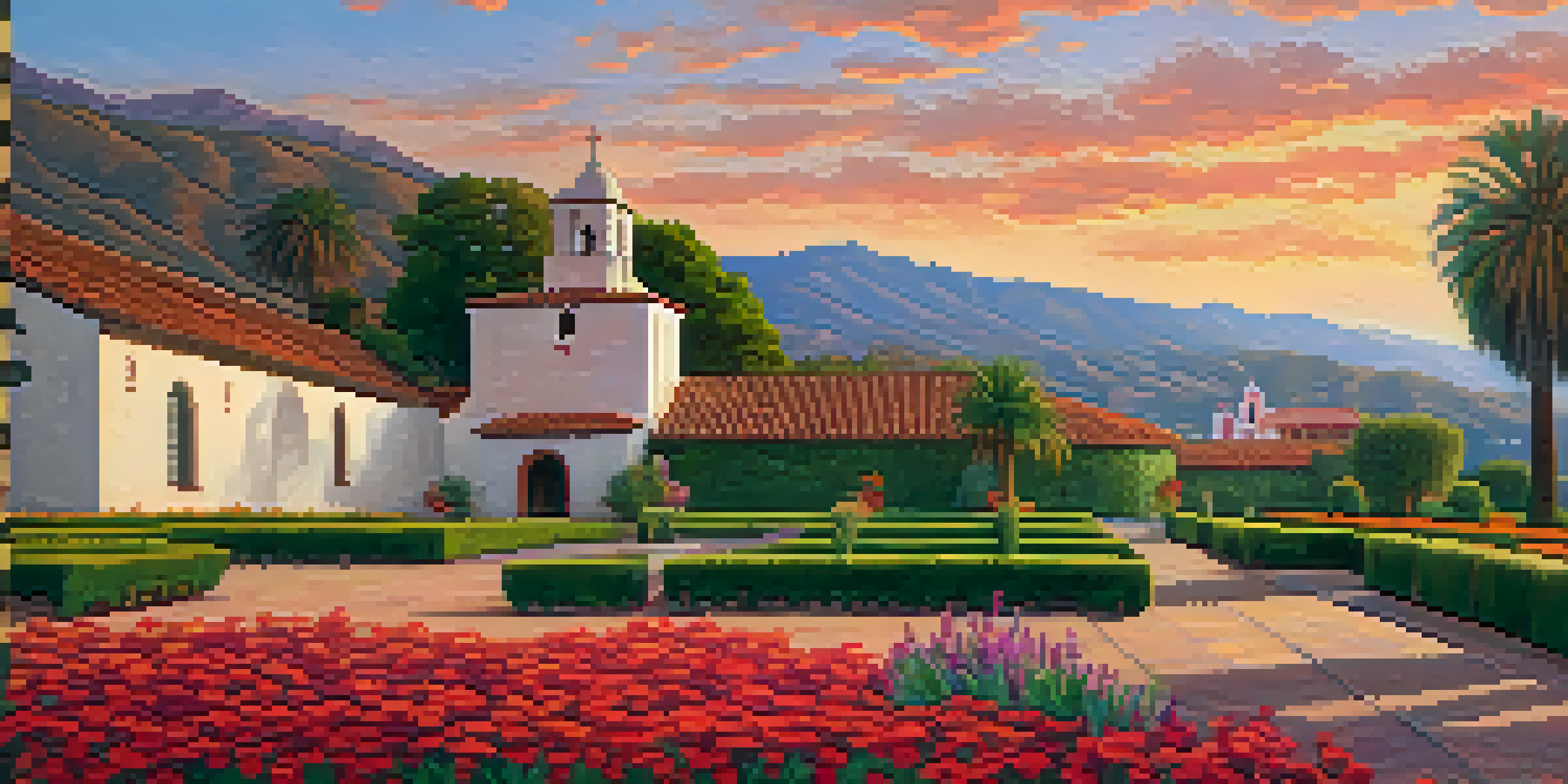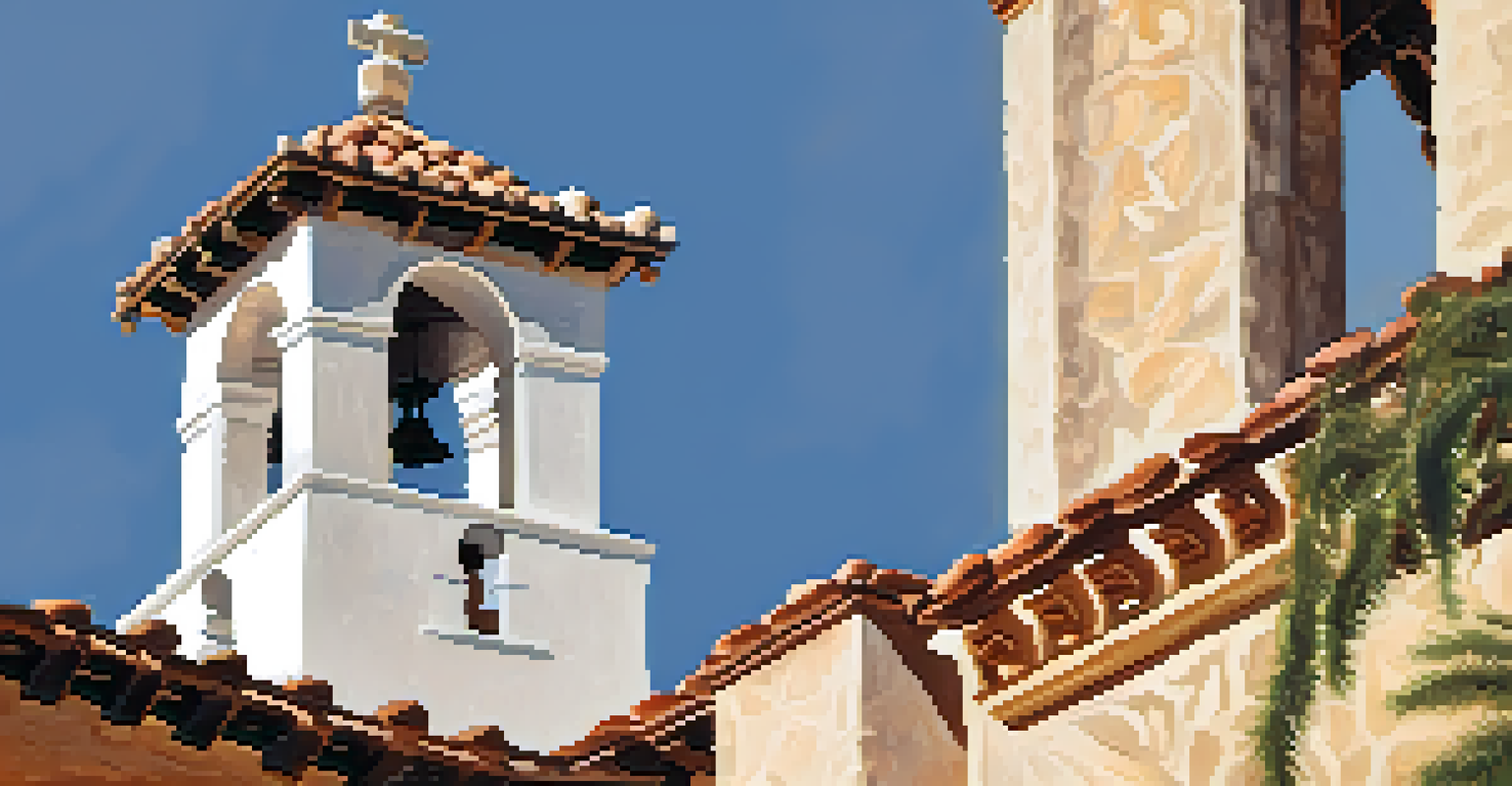Exploring Santa Barbara's Mission: A Historical Overview

The Origins of Santa Barbara Mission: A Glimpse into History
Founded in 1786, Santa Barbara Mission is one of the oldest in California, established by Spanish Franciscan missionaries. The mission aimed to spread Christianity among the indigenous Chumash people and to cultivate agriculture in the region. Its strategic location near the coast made it an ideal spot for trade and communication with other missions.
History is not a burden on the memory but an illumination of the soul.
The mission was named after Saint Barbara, the patron saint of artillerymen, reflecting the military presence in the area during Spanish colonization. Over the years, it became a hub of community life, where religious services and local gatherings fostered a sense of unity among settlers and indigenous populations. This blend of cultures played a crucial role in shaping the mission's identity.
Today, the mission stands as a testament to the resilience of its founders and the enduring legacy of their efforts. Visitors can step back in time, exploring the mission's architecture and gardens that tell stories of a bygone era. It's a place where history isn't just learned; it's experienced.
Architectural Features: A Blend of Styles
Santa Barbara Mission showcases a unique blend of architectural styles that reflect its rich history. The mission features typical Spanish colonial elements, such as adobe walls and red-tiled roofs, combined with Moorish influences seen in its arches and decorative tilework. This fusion not only highlights the artistic vision of its builders but also the diverse cultural influences that shaped the region.

One of the most striking aspects of the mission is its bell tower, which houses a set of historic bells that have called the faithful to prayer for centuries. Each bell has its own story, contributing to the mission's charm and historical significance. The serene gardens surrounding the mission provide a peaceful setting for reflection and appreciation of its beauty.
Historical Significance of Mission
Santa Barbara Mission, founded in 1786, played a crucial role in spreading Christianity and agriculture among the indigenous Chumash people.
As you wander through the mission, the careful attention to detail becomes apparent. From the intricate woodwork to the beautifully painted frescoes, every feature tells a story of devotion and craftsmanship. This architectural marvel not only serves as a religious site but also as a symbol of Santa Barbara's cultural heritage.
The Role of Santa Barbara Mission in Community Development
Beyond its religious significance, Santa Barbara Mission played a pivotal role in the development of the local community. The mission established agricultural practices that transformed the landscape, introducing crops like grapes, olives, and wheat, which became staples in the region. This agricultural foundation laid the groundwork for what would eventually become a thriving economy.
Preservation of one's own culture does not require contempt or disrespect for other cultures.
The mission also served as an educational center, teaching both Spanish and indigenous languages, along with various trades. This focus on education helped bridge cultural gaps and fostered collaboration between settlers and the Chumash people. The shared knowledge contributed to a more integrated society, enriching the community's cultural fabric.
Even today, the mission's influence can be seen in Santa Barbara's vibrant community life. Local festivals, markets, and cultural events often pay homage to the mission's legacy, ensuring that its history continues to be celebrated and remembered. The mission remains a vital part of Santa Barbara's identity, connecting past and present.
Preserving the Legacy: Restoration Efforts
Over the years, Santa Barbara Mission has undergone numerous restoration efforts to preserve its historical integrity. Natural disasters, particularly the 1925 earthquake, caused significant damage, prompting extensive repair work. These restoration projects were undertaken not only to restore physical structures but also to honor the mission's historical significance.
The dedication to preservation is evident in the careful restoration of the mission's artwork and artifacts. Many original pieces, including religious icons and liturgical items, have been meticulously maintained or restored, allowing visitors to experience the mission as it was during its active years. These efforts ensure that the mission remains a living museum for future generations.
Cultural Hub for the Community
The mission serves as a vibrant cultural center, hosting events that celebrate local heritage and foster community engagement.
Community involvement has been crucial in these restoration efforts. Local volunteers and historians have come together to support the mission's upkeep, highlighting a collective commitment to preserving Santa Barbara's heritage. This spirit of collaboration enriches the mission's story, demonstrating the importance of community in safeguarding history.
Cultural Events at Santa Barbara Mission
Santa Barbara Mission is not just a historical site; it is a vibrant cultural hub that hosts various events throughout the year. From art exhibits to music festivals, the mission opens its doors to the community, inviting everyone to celebrate the arts and local culture. These events often draw large crowds, showcasing the mission's role in fostering community engagement.
One of the most popular events is the annual Fiesta, which brings together locals and visitors to celebrate Santa Barbara's rich cultural heritage. Traditional music, dance performances, and artisan markets create a festive atmosphere that highlights the mission's enduring significance in the community. It's a joyful reminder of how history can unite people through shared celebrations.
Additionally, educational programs and workshops are regularly held at the mission, focusing on topics like local history, arts, and sustainability. These programs not only educate but also inspire participants to connect with their heritage and take part in preserving it. By engaging with the mission, attendees develop a deeper appreciation for the cultural tapestry that makes Santa Barbara unique.
Visitor Experience: What to Expect
Visiting Santa Barbara Mission offers an immersive experience that blends education and exploration. As you enter the grounds, you'll be greeted by lush gardens and the serene ambiance that invites reflection. Guided tours provide insights into the mission's history, architecture, and ongoing efforts to preserve its legacy, making it an enriching experience for visitors of all ages.
The mission's museum showcases artifacts, photographs, and interactive displays that delve deeper into its historical context. Whether you're a history buff or just curious, there's something for everyone to discover. The knowledgeable staff are always on hand to answer questions and share fascinating stories that bring the mission's history to life.
Ongoing Preservation Efforts
Restoration projects at Santa Barbara Mission ensure its historical integrity while involving the community in preserving its legacy.
Don't forget to take a moment to enjoy the stunning views of the surrounding landscape. The mission's location offers picturesque vistas that perfectly complement its historical charm. It's a place where you can not only learn about the past but also appreciate the natural beauty that has inspired generations.
A Lasting Impact: The Mission's Influence Today
The impact of Santa Barbara Mission extends far beyond its historical significance; it continues to shape the community today. As a center for cultural preservation, it inspires ongoing conversations about heritage and identity, encouraging residents to embrace their roots. Local schools often organize field trips to the mission, ensuring that young people learn about their history from an early age.
Moreover, the mission serves as a gathering place for various community initiatives, from environmental conservation efforts to social justice movements. Its grounds are often utilized for community meetings and events that promote dialogue and collaboration. This reflects a commitment to not only preserving history but also using it as a foundation for positive change.

In this way, Santa Barbara Mission remains a vital part of the community's narrative, embodying a spirit of resilience and unity. It stands as a reminder that history is not merely a collection of dates and events; it's a living story that continues to evolve, connecting past, present, and future in meaningful ways.